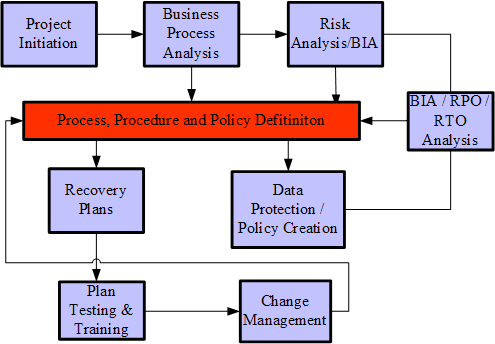| Tool Mentor: TSM - Execute IT Service Continuity Plan |
 |
|
| Related Elements |
|---|
ContextTool mentors explain how a tool can perform tasks, which are part of ITUP processes and activities. The tasks are listed as Related Elements in the Relationships section. You can see the details of how processes and activities are supported by this tool mentor, by clicking the links next to the icons: DetailsIBM® Tivoli® Storage Manager provides the ability to backup and restore files and data over a network transport to a centralized storage system. Usually, the clients of such a system are file and database servers; the transport medium is a LAN, WAN, or SAN; and the centralized storage system is a server with a large amount of tape or disk attached. Whether for simple backup and restore, disaster recovery, or real time data access, such systems are usually implemented with certain performance expectations. The system will backup and restore in a certain number of hours. If a primary site is lost, all critical systems can be restored within a certain number of days. The storage hardware for the system will cost a certain amount and will meet the need for a certain period of time. There are many factors involved in determining the rate of backup and the rate of restore of data including type of storage media, number of backup storage media drives, speed of those drives, speed of a tape robot, time, space, and bandwidth that go into being able to calculate these figures. Any of these can be a critical limiting factor. It is also a matter of how the backups are done. You can either optimize on the backup for faster backups or optimize for restore. The performance can be wildly different depending on how your backup strategy is optimized. Business Continuity Planning (BCP) is an enterprise-wide planning process that creates detailed procedures to be used in the case of a large unplanned outage or disaster. Maintaining continuity of business processes is the overall objective. Disaster Recovery Planning (DR Planning) is a logical subset of the BCP process, which focuses on continuity of IT operations. Tivoli Storage Manager protects and manages data on more than 30 operating platforms. The Tivoli Storage Manager server application is supported on over 10 platforms, and it supports hundreds of disk, tape, and optical storage devices. The Tivoli Storage Manager server software provides built-in device drivers for directly connecting more than 300 different device types from every major manufacturer. Business continuity is achieved through rigorous planning, strategy, and process development. Part of the BCP planning process quantifies the critical business processes, the cost of downtime, and the risks that an organization faces. The risks help to justify the means by which an organization builds availability, disaster tolerance, and disaster recovery capability into the IT infrastructure. The supporting IT infrastructure is closely associated with the Disaster Recovery Planning process. Examples of costs to consider are: direct revenue loss, regulatory agency / IRS penalties, market share loss, and employee downtime.
Given an infinite amount of resources, it is possible to have a Tivoli Storage Manager solution that meets all needs. The fact that the cost is usually prohibitively high to have the perfect backup and restore solution causes choices to be made in the strategy. Another option that Tivoli Storage Manager provides is facilitating site-to-site recovery. By the creation of multiple copies of enterprise data, Tivoli Storage Manager supports the implementation of site-to-site recovery operations. Disaster Recovery with Tivoli Storage Manager includes moving data to off-site locations, rebuilding or initializing Tivoli Storage Manager infrastructure, and reloading data to clients within the time frame that is negotiated in the Service Level Agreement (SLA). Consider testing the recovery plan to see how the plan will or will not meet the identified needs. For More InformationFor more information about this tool, click on the link for this tool at the top of this page. |
©Copyright IBM Corp. 2005, 2008. All Rights Reserved. |
